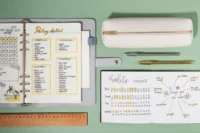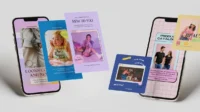In this article:
- 1. A Standout Introduction
- 2. An Updated Resume or Work Experience Section
- 3. Case Studies for Key Projects
- 4. Diverse and Relevant Work Samples
- 5. Clear and Intuitive Navigation
- 6. Testimonials or Client Feedback
- 7. A Personal Touch
- 8. A Call-to-Action and Contact Information
- Crafting a Portfolio That Opens Doors
A design portfolio may be a collection of your work, but it also shares your story. It is how you show potential clients and employers who you are as a designer, what you are capable of and why they should work with you.
However, only some portfolios hit the mark. You have probably scrolled through enough to know when one feels polished versus when it is a jumble of projects thrown together.
How do you ensure your portfolio grabs and keeps attention? The answer lies in the details — the key elements that turn a basic portfolio into a professional, persuasive tool that gets you hired.
1. A Standout Introduction
First impressions matter, especially in your design portfolio. Your introduction is your chance to set the tone and immediately connect with your audience. This section should reflect your personality, design style and professional expertise in a way that feels authentic to you.
When I craft a strong introduction, it is more than a professional headshot and a brief bio. Instead, I make it intentional by giving visitors a glimpse into my creative world and why my work stands out.
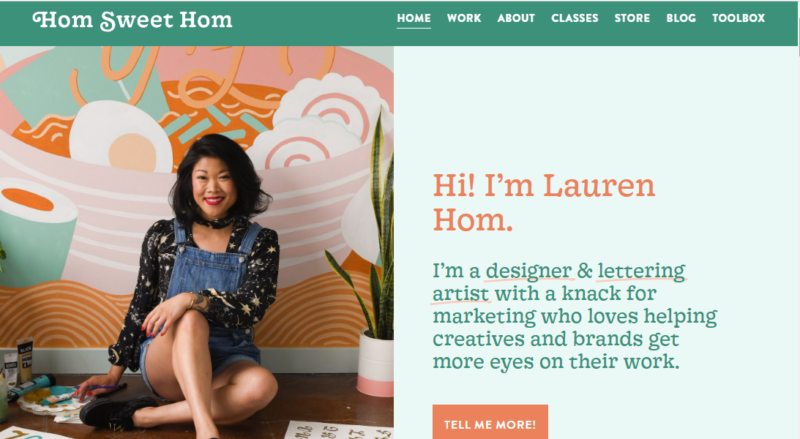
Source: https://www.homsweethom.com/
Hom Sweet Hom is a perfect example of this. Right from the homepage, it welcomes you with bright visuals, a friendly tone, and a playful and bold style. The bio is short but powerful, explaining what she does and why. Then, it uses a call-to-action (CTA) to invite visitors to learn more.
When crafting your introduction, think about the story you want to tell. Are you a minimalist with a clean, sharp aesthetic? Perhaps you feel more alive with bold visuals. Let your introduction reflect who you are while setting the stage for the rest of your portfolio.

Get 300+ Fonts for FREE
Enter your email to download our 100% free "Font Lover's Bundle". For commercial & personal use. No royalties. No fees. No attribution. 100% free to use anywhere.
2. An Updated Resume or Work Experience Section
While your portfolio already showcases your creative expertise, including an updated resume or work experience section ensures you provide all the essential details employers need. Plus, it shows you are detail-oriented and professional. However, getting it right requires attention to design and content.
For instance, correctly using every word and punctuation mark is crucial, as 77% of employers take resumes with poor grammar or typos out of consideration. This is vital even if something has a beautiful design.
Keep the following tips in mind when uploading a copy of your resume to your portfolio:
- Use the right font size and formatting: For maximum impact, choose 14-16 points to make your name clear at the top of the page. Use 12-14 points for section headers, and the main content should be 10-12 points.
- Stick to clean and professional fonts: Avoid overly decorative fonts to prevent distractions from the content. For readability, stick with clean options like Arial, Helvetica or Calibri.
- Target your content: Highlight skills and experiences relevant to your target client or employer. Ensure your job descriptions are concise, action-oriented and highlight measurable results.
Including your education in your resume is always a plus, especially if it’s a university degree in a related field, as it shows a strong foundation. Even if you’re still studying, it’s worth noting; it shows you’re actively developing your skills. At the same time, it’s important to gain as much hands-on experience outside of university as possible, whether through freelance work or personal projects. Balancing all of that can get overwhelming, especially when work tasks start piling up alongside academic deadlines. In those moments, using assignment help can ease the load and help you stay focused on growing professionally.
3. Case Studies for Key Projects
Case studies are one of the top tools to include in your portfolio. They allow you to go beyond showcasing finished designs by walking potential clients through your creative process. Detailing the challenges, your approach and the results gives your audience further insight into your problem-solving abilities and your work’s impact.
Here is how I approached including a case study for a rebranding project in my portfolio:
- Start with context: In my case, I started with a short paragraph introducing an eco-friendly skin care company I worked with. I explained its challenge — an inconsistent brand identity that did not appeal to the target audience. This background gave viewers a reason to stay engaged.
- Outline the problem: Next, I articulated the main issue. For the skin care company, this was due to a lack of cohesive branding. I included its goals to show I understood the client’s needs.
- Highlight the process: This is where I broke down my process, using a mix of text and visuals. This section included research and strategy, concept development and design execution. I also discussed the challenges I encountered and how I overcame them.
- Showcase the results: It is critical to incorporate measurable outcomes. For this project, I included how I achieved a 30% increase in online sales and a 50% markup in social media engagement.
Including this case study in my portfolio helped me land additional branding projects because it showcased my design skills and measurable results. Following this approach, you can create compelling information highlighting your ability to think strategically and deliver results.
4. Diverse and Relevant Work Samples
The purpose of a portfolio is to show off the breadth and depth of your skills. Whether you specialize in branding, UX design or illustration, including various work samples allows visitors to see the full range of what you can do.
Recruiters only spend an average of one to two minutes browsing a portfolio, so focus on quality over quantity. It is better to display a smaller selection of polished projects than to overwhelm viewers with every design you have ever created. Each sample should tell a story — what was the problem, the solution and the results you achieved?
While you select your work samples, consider incorporating various mediums. For instance, include projects of print and digital designs, interactive prototypes and illustrations. Showcasing different types proves how adaptable you are in your work.
Additionally, it is a good idea to highlight your process. Whenever possible, include sketches, mood boards or wireframes to give insight into your design thinking and approach.
5. Clear and Intuitive Navigation
A portfolio can have impressive visuals and projects, but visitors may leave if they cannot find what they are looking for quickly. The navigation is essential for guiding users through your portfolio and making their experience seamless. Before developing my portfolio, I made it my goal to create a logical flow to highlight my strengths while keeping my audience engaged.
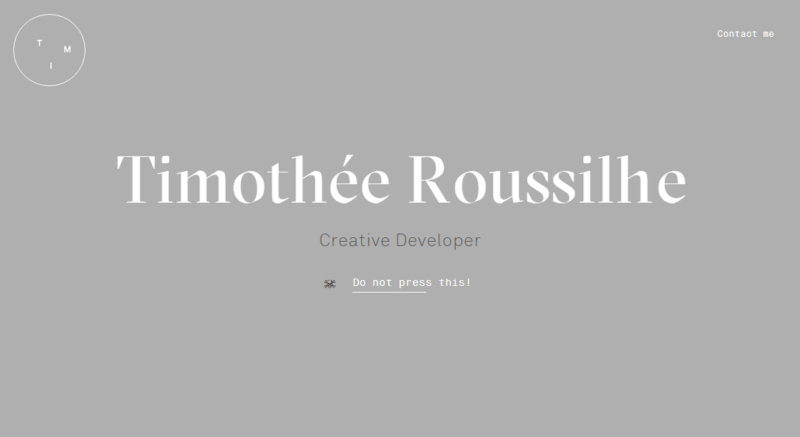
Source: https://timroussilhe.com/
One portfolio that nails navigation is Tim Roussilhe’s. His site uses a minimalist design and a simple menu, allowing visitors to explore his work effortlessly. The navigation is consistent and offers clearly labeled sections for projects.
When crafting your portfolio, make the navigation functional and aesthetically aligned with your style. Remember that the easier it is for visitors to explore your work, the more likely they are to stay, connect and reach out.
6. Testimonials or Client Feedback
Nothing builds trust faster than hearing glowing feedback from past clients or employers. Testimonials provide social proof of your reliability and professionalism. When people read about others’ positive experiences, it reinforces your credibility and increases their confidence in hiring you.
If you have yet to collect testimonials, consider revisiting past clients or employers and ask them for feedback. Most are happy to help when a work relationship ends positively.
Once you have a few testimonials for your portfolio, choose ones spotlighting your key strengths. Whether it is about your creativity or communication skills, you should be selective in showing off your greatest qualities.
Another thing to consider is keeping it authentic. To add credibility, include the client’s name, title and company. If possible, add a photo or logo for extra impact. These aspects prove the clients are real and can make a big difference in creating a lasting impression.
7. A Personal Touch
Your portfolio is also a way to show off who you are as a person. Adding some of your personality makes you memorable and gives potential clients a sense of your values. This can be as simple as including a playful design element, sharing a behind-the-scenes look or showing something about your life outside of work.
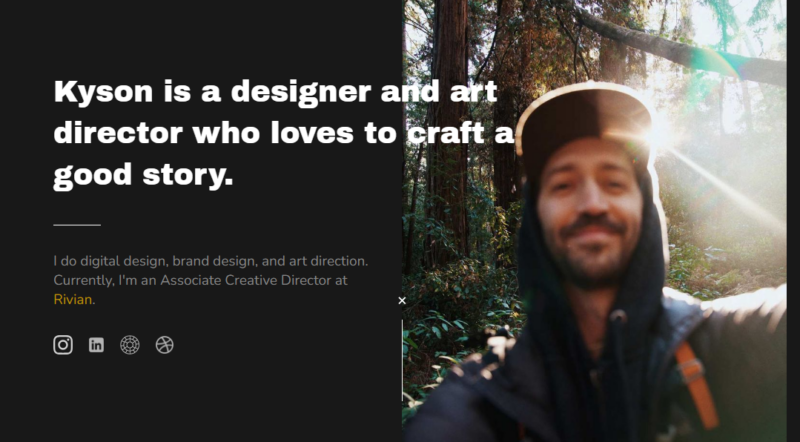
Source: https://www.kysondana.com/
A great example of this is Kyson Dana’s portfolio. Dana includes a photo of himself with the focus of the image on the trees and sunshine behind him, capturing his personality through a smile and love for adventure. While the image is a simple addition, it creates an impact by evoking authenticity and warmth. It shows that he is more than a skilled designer — he is someone with a story to tell.
When done purposefully, personal touches like these create a more engaging experience for your audience. They help potential clients see the real person behind the work, making your portfolio deeply relatable.
8. A Call-to-Action and Contact Information
The ultimate goal of a portfolio is to encourage clients to take the next step in contacting you and scheduling a meeting. A clear and compelling CTA and contact information ensures your audience knows how to get in touch.
Make your CTA actionable and specific. Consider writing something like, “Let’s collaborate on your next project” or “Get in touch to bring your ideas to life.” This method feels more engaging than a simple “Contact Me.” It feels less bland and more inviting to first-time visitors.
Simplicity is also key when providing contact information. Include the best ways to contact you, such as an email address, social media links and a project inquiry form. The form should be concise but cover the essentials, like project scope, timeline and budget. Additionally, mention if you are open to specific projects to set expectations and attract the right inquiries.
Crafting a Portfolio That Opens Doors
Including these essential elements helps your portfolio stand out and hold attention. However, you should update it regularly as your design career evolves. Incorporate new projects, refresh your testimonials and refine your portfolio as you grow. Taking the time to do so will keep it relevant and reflective of who you are as a designer.


